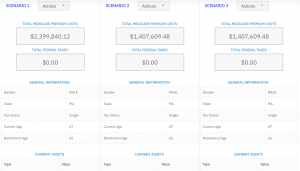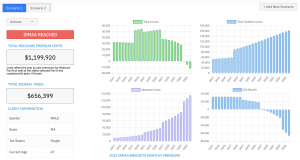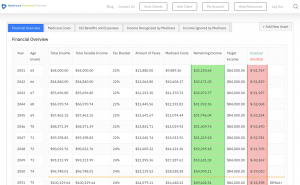Ever felt like you’re playing a high-stakes game of Monopoly with your Medicare coverage ? Like there’s some invisible hand rolling the dice, deciding whether or not you’ll land on 2023 irmaa brackets? Well, that feeling isn’t far from reality.
You see, those “invisible hands” are actually real – they’re just buried deep in tax returns and income calculations. Figuring out this stuff can be like cracking a code.
I’ve been where you are now; bewildered by these complex numbers and their impact on my Medicare irmaa premiums and costs. But don’t worry—I’m here to help guide you through this maze of financial jargon.
Ready for more? Let’s dive deeper into the IRMAA brackets for 2023. We’ll show you how to confidently make your way through them.
What are the IRMAA Premiums and Brackets?
| Individual MAGI | Couple MAGI | Part B Premium | Part D Premium |
|---|---|---|---|
| < $97,000 | < $194,000 | $164.90 | Premium (varies) |
| $97,000 to $123,000 | $194,000 to $246,000 | $230.80 | $12.20 |
| $123,000 to $153,000 | $246,000 to $306,000 | $329.70 | $31.50 |
| $153,000 to $183,000 | $306,000 to $366,000 | $428.60 | $50.70 |
| $183,000 to $500,000 | $366,000 to $750,000 | $527.50 | $70.00 |
| < $500,000 | > $750,000 | $560.50 | $76.40 |
Understanding IRMAA Brackets
If you’re enrolled in Medicare, understanding the Income Related Monthly Adjustment Amounts (IRMAA) is crucial. Don’t worry, we’ll guide you through the 2023 IRMAA brackets and how they may impact your Medicare premiums – the standard Part B monthly premium for 2024 is $174.70. We’ll break down what the 2023 IRMAA brackets are and how they can affect your Medicare coverage.
The standard Part B monthly premium for 2024 is $174.70. Those with higher incomes, though, could be on the hook for more due to the IRMAA surcharge. In fact, Medicare recipients with incomes exceeding certain thresholds will shell out a premium between $244.60 and $594.00 for Part B in 2024.
Essentially, an ‘initial determination’ about your modified adjusted gross income (MAGI) determines whether or not you’ll be hit with this extra charge on top of your regular Medicare plans premium.
An Overview of The IRMAA Bracket System
Much like tax brackets that decide how much income tax you owe based on earnings levels; similarly, there are several different “brackets” when it comes to paying for Parts B and D coverage under Medicare via these additional fees known as ‘IRMAAs’.
In general terms: if your MAGI crosses over into one of these upper-income tiers then congratulations – but brace yourself. You’re now considered part of the club referred to as “higher-income beneficiaries”. And this means increased costs.
Your Modified Adjusted Gross Income / Taxable Income Matters
To figure out where exactly within these brackets someone falls under would require delving deep into their financial details – specifically looking at their modified adjusted gross income (MAGI).
Why does MAGI matter? Because it’s a sum of your adjusted gross income plus any tax-exempt interest, essentially reflecting the true wealth you’ve amassed over time. The higher this figure, the more likely you’ll find yourself in one of those dreaded higher IRMAA brackets.
Examples of Income used to calculate your MAGE:
| Taxable Social Security | Qualified Annuities |
| Wages | Traditional 401(k) Distributions |
| Pension Income | Traditional IRAs Distributions |
| Rental Income | Traditional 403(b) Distributions |
| Capital Gains | Traditional 457 Distributions |
| Dividends (including muni’s) | Traditional SEP-IRA Distributions |
Key Takeaway:
Getting a handle on the 2023 IRMAA brackets can be key to forecasting your Medicare expenses. The more you make, the higher chance you’ll need to cough up an extra fee besides your standard premium. This added cost is tied closely to where you sit within these brackets – it’s all about your modified adjusted gross income (MAGI). So, digging into those financial specifics is pretty crucial.
What is IRMAA and How Does it Work?
The Income Related Monthly Adjustment Amount (IRMAA) plays a critical role in determining Medicare Part B and D premiums. It’s like an extra charge added to your monthly premium if your modified adjusted gross income (MAGI) goes above certain levels.
What’s the scoop with this? Let’s break it down. Your MAGI consists of your tax-exempt interest income plus the adjusted gross from your IRS tax return two years prior. So, for instance, when calculating 2023 IRMAA brackets, they will look at what you earned in 2023.
The Role of Social Security in IRMAA Calculations
Social Security Administration steps into the picture here as well. They use data from federal tax returns to decide who needs to pay higher Medicare premiums via the Income Related Monthly Adjustment Amount Calculator. These calculations are based on specific thresholds that determine whether or not you need to pay an additional amount – aka the ‘IRMAA surcharge’ – on top of your standard plan premium.
If you’re thinking about enrolling for prescription drug coverage or already have a Medicare Advantage Plan with prescription drugs included, then these calculations might apply too. The additional costs due to IRMAA can make quite a difference depending upon where one falls within these ‘income-related’ brackets.
However, it is not a straightforward situation. If life has thrown some curveballs at you recently such as marriage/divorce annulment, work stoppage loss or reduction causing significant changes in pension income or other types of earnings, there may be room for appeal. It’s all about the details and making sure that the Social Security Administration has a clear picture of your financial situation.
It’s important to note that these IRMAA surcharges are not one-time fees but rather an additional monthly cost tacked onto your Medicare premium, which can significantly increase what you pay for healthcare each year. For instance, in 2024, Medicare recipients with incomes exceeding certain thresholds will be paying between $244.60 and $594.00 per month for Part B premiums instead of the standard amount of $174.70.
It might appear as if the calculations are complex, but with a little practice and understanding, they can be easily mastered. Let’s take it one step at a time.
Key Takeaway:
IRMAA, the Income-Related Monthly Adjustment Amount, can hike your Medicare Part B and D premiums if your income exceeds certain levels. The Social Security Administration uses federal tax return data from two years prior to determine these surcharges. If major life changes have occurred since then, you might be able to appeal this additional cost.
How Are IRMAA Brackets Calculated?
You might be wondering, how does your income level determine which IRMAA threshold you fall into and what impact does that have on your Medicare premiums? Well, it’s not as complex as it seems.
Your tax return plays a vital role in this. The Social Security Administration (SSA) takes a look at the adjusted gross income from your IRS tax returns two years prior to calculate where you land within the IRMAA brackets. For instance, if we’re talking about 2023 IRMAA brackets calculation, SSA will use data from your 2023 IRS tax return.
The key element they consider is Modified Adjusted Gross Income (MAGI). MAGI includes more than just wages; think pension income, capital gains and any other taxable interest. So basically all of Uncle Sam’s favorites.
The Role of Your Filing Status
If you’re married filing jointly or qualify for ‘head of household’ status – congrats. You get higher thresholds before bumping up to the next tier compared with single filers or those who are married but file separately.
This difference can greatly affect both parties when considering things like life-changing events such as marriage divorce annulment work reduction work stoppage loss property loss — all could potentially shift someone into another bracket based on changes in their reported incomes.
What Percentage Goes Toward Premiums?
Funny thing is, standard premium rates cover only about 25% of Medicare Part B program costs according to official figures – quite a bargain right? But here comes the tricky part: If your MAGI exceeds certain thresholds, you might be required to pay up to 85% of the costs. Quite a leap, isn’t it?
What does this mean for you? It means that if your income falls within the higher-income beneficiaries’ brackets, you’ll need to dig deeper into your pockets for those Medicare premiums. The difference can vary greatly – it could be a few dollars each month or climb up to several hundred, depending on various factors.
Key Takeaway:
IRMAA brackets are calculated using your Modified Adjusted Gross Income (MAGI) from two years prior. For example, 2023’s IRMAA threshold uses data from the 2023 IRS tax return. Your filing status and any life changes can shift you into different brackets. You should know that if your income lands in higher tiers, this could lead to an increase in Medicare premiums.
Changes to IRMAA Brackets in 2023
The IRMAA brackets for 2023 underwent changes that might impact your Medicare premiums. But don’t sweat it just yet, we’re here to break down what these changes mean for you.
In simple terms, the Income-Related Monthly Adjustment Amount (IRMAA) is an extra charge added to your Part B and prescription drug coverage plan premium if your income goes over a certain limit. It’s like being at a party where they start charging more for drinks after midnight because of high demand.
To understand how this works, think about the tax return you filed two years prior – yes, that old thing. The Social Security Administration uses this information from IRS tax returns when making their initial determination of who needs to pay higher Medicare premiums due to increased income levels.
Your Place on the Ladder: Understanding IRMAA Brackets
The whole process starts with identifying which ‘income bracket’ or level you fall into based on Modified Adjusted Gross Income (MAGI). Imagine climbing up a ladder; each rung represents different MAGI ranges. The further up you go – hello there high earners – the higher your standard premium becomes due to additional surcharges known as IRMAAs.
So let’s talk numbers now because those are our bread and butter in financial planning. In 2024, folks receiving Medicare will see monthly Part B premiums starting at $174.70. However, depending on which ‘rung’ or bracket one falls into based on their reported gross income from two years ago (yes indeed.), they could be paying anywhere between $244.60 and whopping $594.00 per month.
Shuffling the Deck: Changes to the IRMAA Brackets in 2023
healthcare. This shake-up in the IRMAA’s structure led to some folks seeing an increase or decrease in their Medicare premiums, all depending on where they fell within these newly defined income tiers.
Key Takeaway:
$148.50 to $475.20, depending on your income level. Remember, these are just potential charges – actual costs can vary based on other factors too. So if you’re expecting a pay bump soon, it’s good to be aware of how that might affect your Medicare premiums.
Strategies to Minimize IRMAA Surcharges
But did you know that with the right planning, you might lower these costs? Let’s look at some strategies.
The Impact of Roth Conversions on IRMAA
Roth conversions can play a significant role in reducing your IRMAA surcharges. When traditional IRA funds are converted into a Roth IRA, it doesn’t add up to your Modified Adjusted Gross Income (MAGI), which is what Social Security uses when calculating Medicare Advantage Reductions.
This could potentially move you into a lower income bracket for Medicare purposes, thus minimizing or even eliminating the need for an extra premium. It’s like taking two steps forward without having to take one back.
Let’s make this more concrete with an example: say you’re just over the threshold of an IRMAA bracket because of distributions from your traditional IRA account.
- If you convert part of those funds into a Roth account before they’re distributed, they won’t count towards MAGI calculation.
- This conversion may help bring down your overall gross income as reported in IRS tax returns.
- You might fall under another tier within 2023 IRMAA brackets and have smaller Medicare premiums.
Sounds great so far? There’s something else though – each insurance company determines its own premium for Part D drug coverage plans. So if there is any leftover amount after all calculations are done – yes. The rest goes straight onto the premium cost.
Avoiding Unnecessary Capital Gains
Another way to minimize IRMAA surcharges is by avoiding unnecessary capital gains. Though it may seem complex, avoiding unnecessary capital gains is actually quite simple.
When you sell investments that have appreciated in value, you incur capital gains tax. But what many don’t realize is that these taxes also increase your adjusted gross income – and consequently may bump up your Medicare premiums.
- If possible, consider holding onto profitable assets rather than selling them off.
- It could be feasible to not sell off lucrative possessions.
Key Takeaway:
Planning can help you lower IRMAA surcharges on your Medicare premiums. By using strategies like Roth conversions and avoiding unnecessary capital gains, you might just reduce your overall gross income. This could potentially move you into a lower bracket for 2023’s IRMAA tiers, saving money on Medicare costs.
Comparing IRMAA Brackets to Other Medicare Costs
When it comes to ensuring financial stability in retirement, comprehending the complexities of Medicare costs is essential. Especially knowing what will medicare cover and what it won’t. One area that often trips people up is the Income-Related Monthly Adjustment Amount (IRMAA). So let’s take a deep dive into comparing 2023 IRMAA brackets with other standard and additional Medicare costs.
The Social Security Administration determines whether you need to pay an extra amount on top of your regular Part B or prescription drug coverage plan premium based on income reported two years prior on your IRS tax return. This includes not only wages but also capital gains, pension income, and any modified adjusted gross incomes.
Understanding Standard Premiums vs IRMAA Surcharges
Your monthly premiums for Parts B and D depend heavily on which bracket you fall into according to the HI 01101.020 IRMAA Sliding Scale Tables. The standard Part B monthly premium for 2024 is $174.70 as set by CMS; however, higher-income beneficiaries may end up paying more due to their position within these so-called “brackets”.
In fact, if you’re married filing jointly with an adjusted gross income over $182k or single with over $91k (as per figures from IRS tax returns), then brace yourself because these numbers put you right inside one of those dreaded ‘higher’ brackets. That means instead of just paying the base rate like most medicare beneficiaries do – say hello my friend –to a new world where between $244.60 and $594.00 are debited every month.
IRMAA vs Prescription Drug Costs
Just like Medicare Part B, the Part D premium – which takes care of your prescription drug coverage – can be a bit more complex. Each insurance company sets its own rates for these plans. If you’re in one of the higher income brackets based on your modified adjusted gross income from two years ago (as per those tax return figures), you’ll also need to pay an IRMA.
Key Takeaway:
It’s important to understand Medicare costs, including the 2023 IRMAA brackets. This can help manage your healthcare expenses once you retire. Your Part B and D premiums depend on where you fall in the IRMAA sliding scale tables. If your earnings exceed $182k for joint filers or $91k if single, anticipate higher payments starting from $244.
FAQs
What is the IRMAA threshold for 2023?
The IRMAA thresholds in 2023 are based on your tax return from two years prior. They vary depending on filing status and income.
What will the IRMAA brackets be for 2024?
The exact figures aren’t released yet, but expect them to rise slightly due to inflation adjustments made by the Social Security Administration. NOTE this does not cover Medicare Advantage or Medicare Supplement plans.
Are IRMAA Surcharges and Premiums based on AGI or taxable income?
MAGI, or Modified Adjusted Gross Income, is used to calculate IRMAA. It includes your AGI plus any tax-exempt interest.
Do both spouses pay Irmaa?
With medicare enrollment, if you’re married and file jointly, both spouses may pay an IRMAA if combined incomes exceed certain levels set by the SSA. NOTE this does not cover Medicare Advantage or Medicare Supplement plans.
Conclusion
Navigating the 2023 IRMAA brackets is like navigating a labyrinth, but it’s not impossible. You’ve learned what they are and how they affect your Medicare premiums. NOTE this does not cover Medicare Advantage or Medicare Supplement plans.
Remember that Social Security uses tax return data to calculate IRMAA, affecting both Part B and D premiums. And yes, your income level determines which bracket you fall into—so keep an eye on those dollars!
Keep in mind changes to the brackets can happen annually. But don’t panic – there are strategies available to minimize surcharges, such as Roth conversions.
You now comprehend this intricate arrangement. Remember these key points; apply them wisely for more manageable Medicare costs.
Streamlining the Medicare Surcharge Calculation Process.
Our Healthcare Retirement Planner software is designed to streamline the retirement planning process for financial professionals. By providing an efficient way to calculate IRMAA costs, our tool helps you save time and focus on other aspects of your clients’ retirement plans.
- Faster calculations: Our software quickly calculates IRMAA costs based on your client’s income and tax filing status, eliminating manual calculations and potential errors.
- User-friendly interface: The intuitive design of our platform makes it easy for financial professionals to input data and generate results with minimal effort.
- Data integration: Seamlessly integrate our calculator into your existing financial planning tools or CRM systems for a more streamlined workflow.
- Easy to Understand Reports: Export reports to easily share with your clients
- Tax and Surcharge Modeling: see how different types of income affects both taxes and your surcharges.
In addition to simplifying the calculation process, using our Healthcare Retirement Planner can also help improve communication between you and your clients. With clear visuals that illustrate how IRMAA costs impact their overall retirement plan, you can effectively convey complex information in an easily digestible format. This enables clients to make informed decisions about their healthcare expenses during retirement while ensuring they are prepared for any potential changes in Medicare premiums due to income fluctuations. To learn more about how our software can benefit both you as a financial professional and your clients’ retirement planning experience, visit the features page. Streamlining retirement planning processes can help financial professionals save time and resources, allowing them to focus on other areas of their clients’ needs. Automated calculation of IRMAA costs is the next step in streamlining this process even further.





